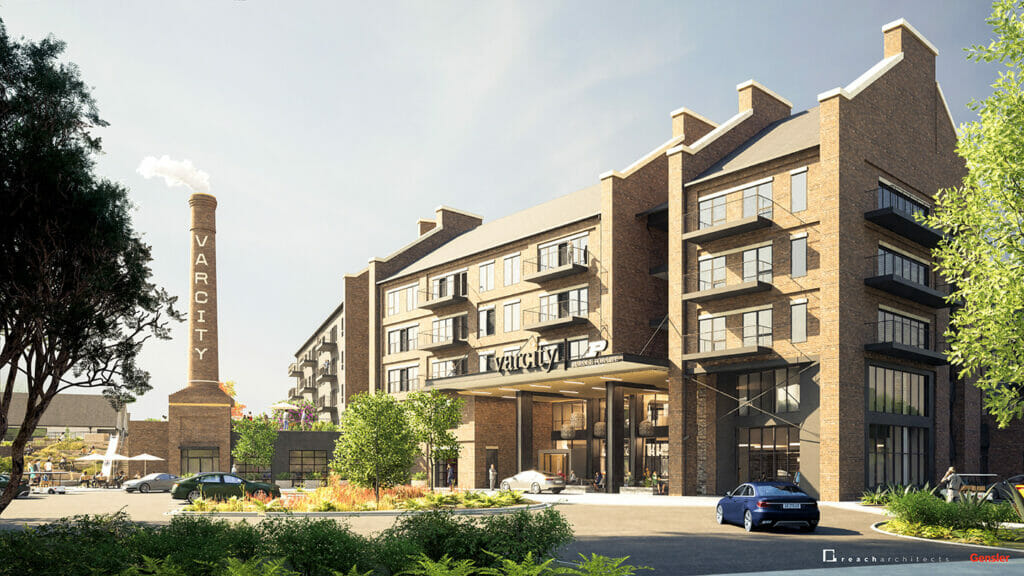
As older baby boomers continue to change the traditional idea of senior living, a Texas-based developer is working with universities to create intergenerational, wellness-infused residential developments.
Varcity, a McNair Living brand with a tagline of “Campus life … for life,” will break ground on its first university-affiliated residential development next year on the Purdue University campus, with a 2026 planned opening. Varcity at Purdue will be located in the middle of an on-campus, mixed-use neighborhood and provide a variety of housing options for older adults, along with multiple restaurants and lifelong learning opportunities.
Les Strech, McNair chief operating officer and managing principal, said that Varcity’s residential-over-retail, intergenerational living concept eliminates generational separation and reinvents campus life by providing residents with access to community, educational and recreational activities, along with supportive services.
“Varcity started with the core conviction that people of all ages were meant to live in community, and the growing appetite to learn as a lifelong initiative,” Strech said. “Our longevity-based communities are at the forefront of reinventing the senior living paradigm, using real estate development to create the proximity that allows purpose, community and belonging at every stage of life.”
Varcity’s Collegiate Intergenerational Centers of Excellence, or C-ICE, model lays out longevity, healthcare, academic, programming and diversity requirements for communities. Among the components of the model:
- Centers are located on or within one mile of campus.
- They have exclusive branding and affiliation rights.
- They have student-driven therapy programs.
- They have lifelong learning programs.
Strech said that his goal through the C-ICE process was to find what worked in senior living and make it better. Although he said that his Varcity model is not the solution, it is one solution.
“We were able to take time and see what was working and craft it into something relevant and effective for the next decade or two,” Strech said. “Varcity communities will be full of life for all ages.”
Varcity at Purdue
Varcity at Purdue will provide to residents dedicated health and wellness support, including telehealth and telemedicine, physical therapy facilities, assisted living options and more. Residents will have Purdue ID cards, giving them access to university facilities, including opportunities to audit lecture courses at no charge.
Freestanding villas, along with one-, two- and three-bedroom condos, will be located above ground-floor amenities specifically designed to promote interaction with students, faculty and the larger community, including space for group meetings, art exhibitions and intergenerational engagement.
The affiliation includes a collaboration with the university on research, teaching, student internships and service opportunities.
Strech said that several other Varcity locations are in the planning stages with Big 10 and Southeastern Conference schools across the country.
Senior living shakeup
Strech said that today’s baby boomers (currently aged 58 to 77) are not interested in retiring and that traditional senior living communities have fallen out of favor with the next generation of prospective residents. Varcity communities, he added, will focus on the health span, not just the lifespan, with residents able to take a longevity test upon move-in that measures their chronological age against their current physical health. The test can be repeated annually to show them how Varcity’s physical environment, nutritional planning and social structures increase the number of quality years lived.
Since the first retirement home opened on a college campus in 1983, Strech said, more than 75 senior living-university affiliations have launched across the country. The challenge now, he said, is that baby boomers have no interest in retiring to most of those communities, many of which are located too far from college campuses, have few formal commitments with higher education institutions, lack an alumni base or are tied to continuing care retirement / life plan communities with buy-in rates that price alumni out of the model.
“Society is moving toward ‘We want to be appreciative of people at all ages.’ We haven’t been,” Strech said. “The heartbeat of Varcity environments [is] where it’s normal to look to the left and look to the right and see all ages around you in learning environments.”
To provide a one-stop directory of information for retirees interested in senior living communities associated with higher education institutions, former senior living executive Andrew Carle recently launched the UniversityRetirementCommunties.com website. He also is creating a certification program for university retirement communities.


